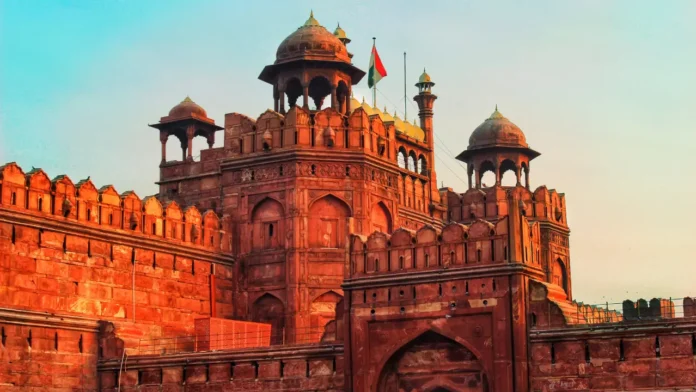For centuries, Delhi’s Red Fort — the magnificent fortress built by Emperor Shah Jahan — has stood as a symbol of India’s pride and architectural brilliance. In recent years, visitors and conservationists have noticed an alarming change: the fort’s once-bright red walls are slowly turning blackish and dull.
What appears to be simple discolouration is actually a chemical and environmental crisis in progress. The fort’s red sandstone surfaces are being coated with a thin layer of black crust caused by air pollution, chemical deposits, and particulate matter that have settled over time.
The Science Behind the Blackening
Researchers studying the Red Fort have found that the black patches are pollution-induced crusts made up of mineral compounds and soot particles.
These crusts form when pollutants like sulfur dioxide, nitrogen oxides, and particulate matter (PM2.5 and PM10) mix with moisture in the air and react with the fort’s sandstone surface. Over time, this chemical interaction produces gypsum and other compounds that harden and cling to the monument, creating a blackened, rough layer.
The crust thickness varies from a thin film to several millimeters — enough to mask the natural colour and even damage the surface texture of the red sandstone.
What This Means for the Monument
The blackening of the Red Fort isn’t just a cosmetic issue; it poses a serious threat to the structure’s longevity and aesthetics.
Here’s how it’s affecting the fort:
- Loss of intricate details: Fine carvings and delicate floral motifs are being buried under layers of pollution and mineral deposits.
- Surface decay: The gypsum crust retains moisture, leading to flaking and blistering of the sandstone underneath.
- Weakened structure: The trapped dampness accelerates erosion and may lead to irreversible damage over time.
- Colour distortion: The vibrant red hue of the sandstone is gradually fading, replaced by dull grey and black patches that obscure its royal appearance.
Experts warn that if left untreated, the crusts could permanently alter the fort’s surface, making restoration extremely difficult.
Delhi’s Air Pollution: The Prime Reason
Delhi’s deteriorating air quality is at the heart of this transformation. The city’s high levels of vehicular emissions, construction dust, and industrial pollutants have made it one of the most polluted capitals in the world.
Every day, thousands of vehicles pass near the Red Fort, releasing carbon, sulfur, and nitrogen compounds into the atmosphere. These particles eventually settle on the monument, mixing with humidity and forming the black deposits seen on the fort’s walls.
The fort’s location, surrounded by heavy traffic and urban activity, makes it especially vulnerable to pollution-driven corrosion.
A Heritage Under Threat
Built between 1639 and 1648, the Red Fort has witnessed the Mughal era, India’s colonial past, and its rise as an independent nation. Today, it’s not the weather or wars that threaten it — but modern pollution.
The blackening is symbolic of a larger challenge: India’s heritage monuments are silently bearing the brunt of urban industrialization and neglect. Similar effects have been seen on Delhi’s other sandstone structures like Humayun’s Tomb and the Qutub Minar complex.
What Can Be Done to Save the Red Fort
To prevent further darkening and decay, conservationists and experts suggest the following measures:
- Regular cleaning and maintenance: Gentle, non-invasive cleaning methods must be used periodically to remove pollution deposits before they harden.
- Protective coatings: Specialized breathable coatings can help shield the sandstone from direct exposure to pollutants.
- Pollution control measures: Restricting vehicle movement and construction near heritage zones can significantly reduce particulate buildup.
- Continuous monitoring: Regular inspections and scientific assessments will help identify new damage early.
- Public awareness: Educating citizens about the effects of pollution on monuments can create pressure for policy changes and civic responsibility.
More Than a Monument — A National Symbol
The Red Fort is more than an architectural marvel — it’s a living emblem of India’s independence and identity. The tricolour hoisted here every Independence Day represents the resilience and unity of a nation that emerged from centuries of history.
But the darkening of its walls is a stark reminder that environmental neglect has cultural consequences. Protecting the Red Fort is not just about preserving bricks and stone — it’s about safeguarding our shared heritage and history for generations to come.
